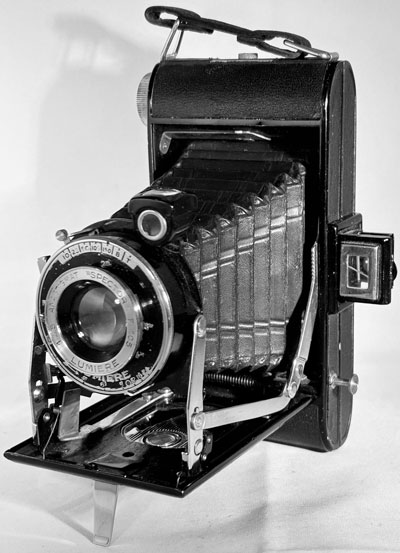Lumière Lumirex II
Specification

| Manufacturer | : | Lumière |
|---|---|---|
| Produced | : | 1946 |
| Classification | : | Medium format |
| Body Type | : | Folding bed |
| Bellows Deployment | : | Self erecting |
| Construction | : | Metal |
| Film Type | : | 620 |
| Film Width | : | 62mm |
| ImageSize | : | 2¼ x 3¼ in |
| No. of Images | : | 8 |
| Lens Type | : | Anastigmat "Spectator"/td> |
| Focal Length | : | 105mm |
| Focus Type | : | Variable |
| Focus Range | : | 2m to inf |
| Aperture Type | : | Variable Iris |
| Aperture | : | f/4.5 to f/24 |
| Shutter Type | : | Self Cocking |
| Shutter Speeds | : | T,B,I(1/10, 1/25, 1/50, 1/100, 1/150 sec) |
| Shutter Delay (optional) | : | 5 seconds) |
| Size Open (w x h x d) | : | 90 x 160 x 128 mm |
| Size Closed (w x h x d) | : | 90 x 160 x 35 mm |
| Weight | : | 185g |
Art Deco Credentials
![]()
![]()
![]()
Acceptable: Modest and restricted
- Produced after the main Art Deco period;
- Black & chrome face plate;
- Chrome embellishments to body and tripod mounts;
- Chrome embellishments to film door lock, viewfinder and winder;
- Chrome decorative plate on inside of folding bed.
- Chrome erecting mechanism.
- Embossed pattern on back and bellows.
Description
The Lumière Lumirex II was manufactured between 1946 and 1959. It is a self-erecting folding camera. This particular version finished in 1952. There was a modernised version from 1952 to 1959 which had a coated lens and flash contacts.
It has a front focussing f/4.5 lens with focussing from less than 2m to infinity.
The Lumirex II has a shutter with slow speeds, initially limited to 1/150 but went to 1/300 (with flash sync and pre-cocking) from 1952. There is a 5 second delay self-timer. There is a shutter release on the body of the camera but it can be triggered on the lens standard.
Tt had two viewfinders, a swivelling one on the lens standard and a fixed 'sports' viewfinder on the body, which can be folded for safe storage.
It has two tripod sockets for portrait and landscape operation.
The red window on the back has a swivelling cover.
How to Use
Find the manual in French here:- Lumière Lumirex II
This camera takes 620 film which is still available from selected photographic outlets. Although the actual film is the same as 120 film, the spools are different. The 620 spools are slightly shorter and have a smaller diameter. Do not use 120 film in this camera because it will jam and may snap. It is possible to cut down a spool of 120 film to fit or to re-spool some 120 film onto 620 spools in a darkroom or changing bag.
If you are concerned about the exposure settings for this camera then don't worry. Either use the 'Sunny 16 rule' or the more simple 'Outdoor 8' rule.
If you don't want to bother with an exposure meter, follow the guide shown. It is based on the 'Sunny 16' rule. Film is so forgiving and will produce acceptable results even when overexposed by 1 or 2 stops or underexposed by 1 stop.
Remember that the exposure guide in the camera user manual may not be helpful as it is based on the use of old film with a low ISO value.
The tables assume that the sun is at least 30 degrees above the horizon - that's 10am - 5pm on a summer's day (May-August) in the UK.
If you are not sure about the light level, err on the side of overexposure - i.e. assume the smaller f number.
Where there is a choice, a larger f number will give a larger depth of field. To reduce shake choose a faster shutter speed.
For the slower speeds, you may need a tripod to stop blur through shake.
Using ISO 100/125
Key: Green - Good exposure; Amber - acceptable exposure; Red - unacceptable exposure. Number of stops over or under shown.
| Weather Conditions | Shadow Detail | Shutter Speed (s) | ||
|---|---|---|---|---|
| 1/50 | 1/100 | 1/150 | ||
 Sunny SunnySnow/Sand | Dark with sharp edges | f/24 +1 | f/24 | f/24 |
 Sunny Sunny | Distinct | f/24 | f/16 | f/16 |
 Slight Overcast Slight Overcast | Soft around edges | f/16 | f/12 | f/12 |
 Overcast Overcast | Barely visible | f/12 | f/8 | f/8 |
 Heavy Overcast Heavy Overcast | None | f/8 | f/6.3 | f/6.3 |
 Open Shade Open Shade/Sunset | None | f/6.3 | f/4.5 | f/4.5 |